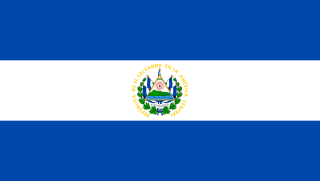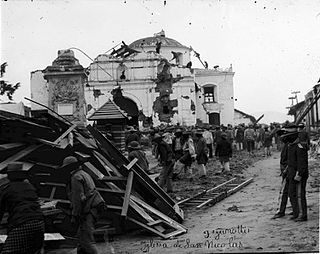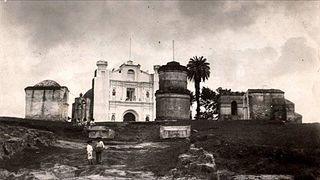
Central America is a subregion of North America. Its political boundaries are defined as bordering Mexico to the north, Colombia to the southeast, the Caribbean to the east, and the Pacific Ocean to the southwest. Central America is usually defined as consisting of seven countries: Belize, Costa Rica, El Salvador, Guatemala, Honduras, Nicaragua, and Panama. Within Central America is the Mesoamerican biodiversity hotspot, which extends from southern Mexico to southeastern Panama. Due to the presence of several active geologic faults and the Central America Volcanic Arc, there is a high amount of seismic activity in the region, such as volcanic eruptions and earthquakes, which has resulted in death, injury, and property damage.

El Salvador, officially the Republic of El Salvador, is a country in Central America. It is bordered on the northeast by Honduras, on the northwest by Guatemala, and on the south by the Pacific Ocean. El Salvador's capital and largest city is San Salvador. The country's population in 2024 was estimated to be 6 million according to a government census.

El Salvador is a country in Central America. Situated at the meeting point of three tectonic plates, it is highly seismologically active and the location of numerous earthquakes and volcanic eruptions. The country has a tropical climate.

Guatemala City, is the national capital and largest city of the Republic of Guatemala. It is also a municipal capital of the Guatemala Department and the most populous urban metropolitan area in the region of Central America. The city is located in the south-central part of the country, in a mountain valley called Valle de la Ermita.

San Salvador is the capital and the largest city of El Salvador and its eponymous department. It is the country's largest agglomeration, serving as the country's political, cultural, educational and financial center. The municipality of San Salvador has 525,990 inhabitants (2024). The Metropolitan Area of San Salvador, which comprises the capital itself and 13 of its municipalities, has a population of 2,404,097. The urban area of San Salvador has a population of 1,600,000 inhabitants.

Antigua Guatemala, commonly known as Antigua or La Antigua, is a city in the central highlands of Guatemala. The city was the capital of the Captaincy General of Guatemala from 1543 through 1773, with much of its Baroque-influenced architecture and layout dating from that period. These characteristics had it designated as a UNESCO World Heritage Site in 1979. Antigua Guatemala serves as the capital of the homonymous municipality and the Sacatepéquez Department.

The Federal Republic of Central America, initially known as the United Provinces of Central America, was a sovereign state in Central America that existed between 1823 and 1839/1841. The republic was composed of five states, and a Federal District from 1835 to 1839. Guatemala City was its capital city until 1834, when the seat of government was relocated to San Salvador. The Federal Republic of Central America was bordered on the north by Mexico, on the south by Gran Colombia and on its eastern coastline by the Mosquito Coast and British Honduras, both claimed by the federal republic.
San Pedro Masahuat is a municipality in the La Paz department of El Salvador. It is located in the central part of the country, approximately 40 kilometers south of the capital city, San Salvador, and is known for its agricultural activities and cultural traditions.
San Martín Jilotepeque is a town, with a population of 10,812, and a municipality in the Chimaltenango department of Guatemala. It was the site of a bus accident in 2013.

The Captaincy General of Guatemala, also known as the Kingdom of Guatemala, was an administrative division of the Spanish Empire, under the viceroyalty of New Spain in Central America, including present-day Costa Rica, Nicaragua, Honduras, El Salvador, Guatemala, and the Mexican state of Chiapas. The governor-captain general was also president of the Royal Audiencia of Guatemala, the superior court.

On 13 January 2001, at 11:33 CTZ, a Mw 7.7 earthquake struck off the coast of Usulután Department, El Salvador, at a depth of 60 km (37 mi). At least 952 people were killed; 944 in El Salvador and 8 in Guatemala, over 5,500 were injured and nearly 200 were left missing due to the earthquake; every single department in the country reported casualties and severe damage, and damage from the earthquake was reported in five countries throughout Central America.

Pedro Ortiz de la Barriere Castro was a Spanish politician, military officer, and lawyer who served as the colonial intendant of the Intendancy of San Salvador from 1819 until 1821. He also served the first head of state of the Province of San Salvador after the signing of the Act of Independence of Central America from September to November 1821. He was killed in action at the Battle of Milingo during the First Central American Civil War.

The 1902 Guatemala earthquake occurred on April 18 at 8:23 pm with a moment magnitude of 7.5 and a maximum Mercalli intensity of VIII (Severe). The rupture was initiated at a depth of 25 km (16 mi) and the duration was 1 to 2 minutes.

El Salvador – sovereign country located on the Pacific Coast of Central America. The area was originally called by the Pipil "Cuzcatan", in Spanish "Cuzcatlan", which in Nahuat means "The Land Of Precious Things". After the Spanish conquest, the land was divided into the province of San Salvador and the province of Izalcos ; until in 1824 the two jurisdictions were united in the State, now Republic, of El Salvador. The country borders the Pacific Ocean between Guatemala and Honduras. With a population of approximately 5.8 million people, it is the most densely populated nation in Central America and is undergoing rapid industrialization.

Guatemala, officially the Republic of Guatemala, is a country in Central America. It is bordered to the north and west by Mexico, to the northeast by Belize, to the east by Honduras, and to the southeast by El Salvador. It is hydrologically bordered to the south by the Pacific Ocean and to the northeast by the Gulf of Honduras.

The 1773 Guatemala earthquake struck colonial Guatemala on July 29 at 15:45 local time. It had an estimated epicentral magnitude of 7.5 Mi. It was part of a sequence that started in May that year. There were two strong foreshocks on June 11 and the mainshock was followed by numerous aftershocks which lasted until December 1773. The series of all these earthquakes is also referred to as the Santa Marta earthquake(s) as it had started on the feast day of Saint Martha.

The Holy Church Cathedral Metropolitan Basilica of Santiago de Guatemala also Metropolitan Cathedral, officially Catedral Primada Metropolitana de Santiago, is the main church of Guatemala City and of the Archdiocese of Guatemala. It is located at the Parque Central in the center of the city. Its massive structure incorporates baroque and classical elements and has withstood numerous earthquakes. Damage by the devastating earthquakes of 1917 and 1976 has been repaired. The inside of the cathedral is relatively sparsely decorated but impresses by its size and its structural strength. The altars are ornate and decorative. In front of the cathedral stand a series of 12 pillars, solemnly remembering the names of thousands of people forcibly disappeared or murdered during the counterinsurgency violence of Guatemala's internal armed conflict, which began in 1960 and lasted until the final peace accord was signed in 1996.

Santiago de los Caballeros de Guatemala was the name given to the capital city of the Spanish colonial Captaincy General of Guatemala in Central America. It is located in present-day Antigua Guatemala.

Human settlement on the present site of Guatemala City began with the Maya who built a city at Kaminaljuyu. The Spanish colonists established a small town, which was made a capital city in 1775. At this period the Central Square with the Cathedral and Royal Palace were constructed. After Central American independence from Spain the city became the capital of the United Provinces of Central America in 1821.

The Spanish conquest of El Salvador was the campaign undertaken by the Spanish conquistadores against the Late Postclassic Mesoamerican polities in the territory that is now incorporated into the modern Central American country of El Salvador. El Salvador is the smallest country in Central America, and is dominated by two mountain ranges running east–west. Its climate is tropical, and the year is divided into wet and dry seasons. Before the conquest the country formed a part of the Mesoamerican cultural region, and was inhabited by a number of indigenous peoples, including the Pipil, the Lenca, the Xinca, and Maya. Native weaponry consisted of spears, bows and arrows, and wooden swords with inset stone blades; they wore padded cotton armour.

















